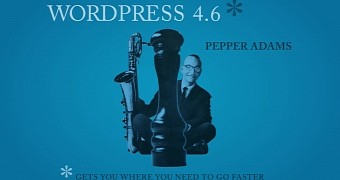WordPress 4.6 has been released today, and users have lots of good reasons to update to the latest version, besides the obvious security-related updates.
In development since April, when WordPress 4.5 debuted, WordPress 4.6 comes with the usual source code updates that every WP release brings, but this time, the team has packed lots of UI updates for the CMS' backend administration panel, something that they haven't focused on as much in recent releases.
New admin panel fonts
First and foremost, as we reported in May, the WordPress admin panel is going to look different after you update. Not too much, but enough for you to notice.
The reason is that WordPress 4.6 has dumped the Google Fonts-hosted Open Sans typography and will load the default system font on each operating system.
The WP team opted for this design choice for the sake of performance. Because the CMS won't have to load the font, the backend pages have shaved some milliseconds off their total load time and are now just a little bit faster.
More AJAX! Everybody loves AJAX UIs
The second biggest update is the usage of AJAX-based real-time updates in more places around the CMS' backend.
Installing, deleting, or updating themes and plugins does not require admins to navigate countless different pages, which indirectly means for multiple seconds waiting for the backend to load just to press a button.
Everything is done from one single page, and admins don't waste their time anymore when carrying out basic maintenance tasks.
More WYSIWYG editor updates
The WordPress team has also continued to improve on its WYSIWYG editor, which has again received updates, two of them.
First, the editor now notifies users if they copy-paste a broken link. The item is highlighted in red, allowing users to correct it before their article goes live.
Second, the editor now uses HTML5 local storage features to save article copies if the Internet connection goes down. Users can continue to write their posts, which get saved to their PCs. When the Internet connection returns, users can navigate to the same page, and WordPress will ask them if they want to load the locally stored article version inside their page.
No WP API
The rest of the changes made to WordPress in version 4.6 focused on site performance improvements.
As we previously reported in April, WordPress 4.6 did not receive the long-awaited WP API, which has been deferred to version 4.7.
ordPress website owners can upgrade to this new version via their CMS' built-in update manager. Users who are installing WordPress from scratch can download the latest version from Softpedia, GitHub, or the official website.

 14 DAY TRIAL //
14 DAY TRIAL //